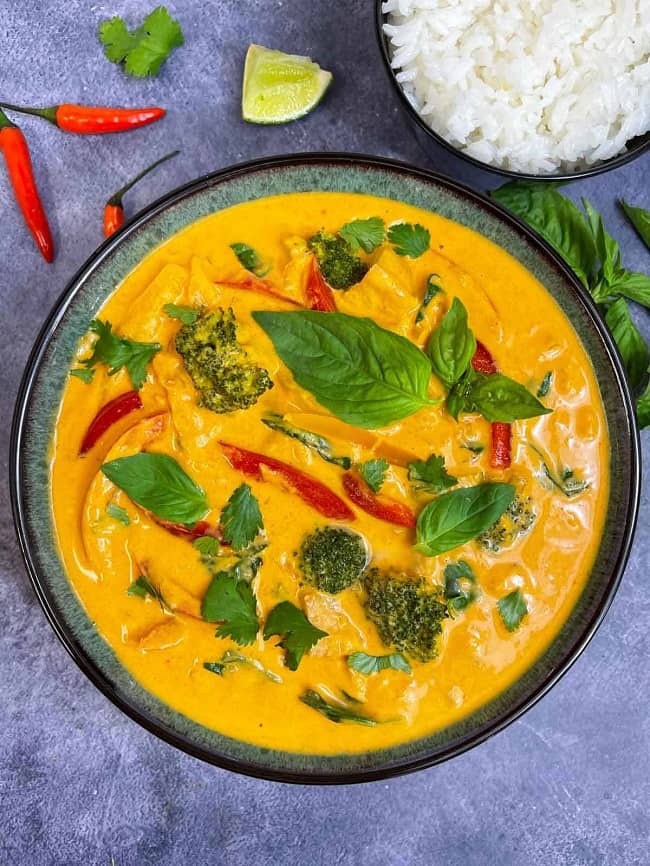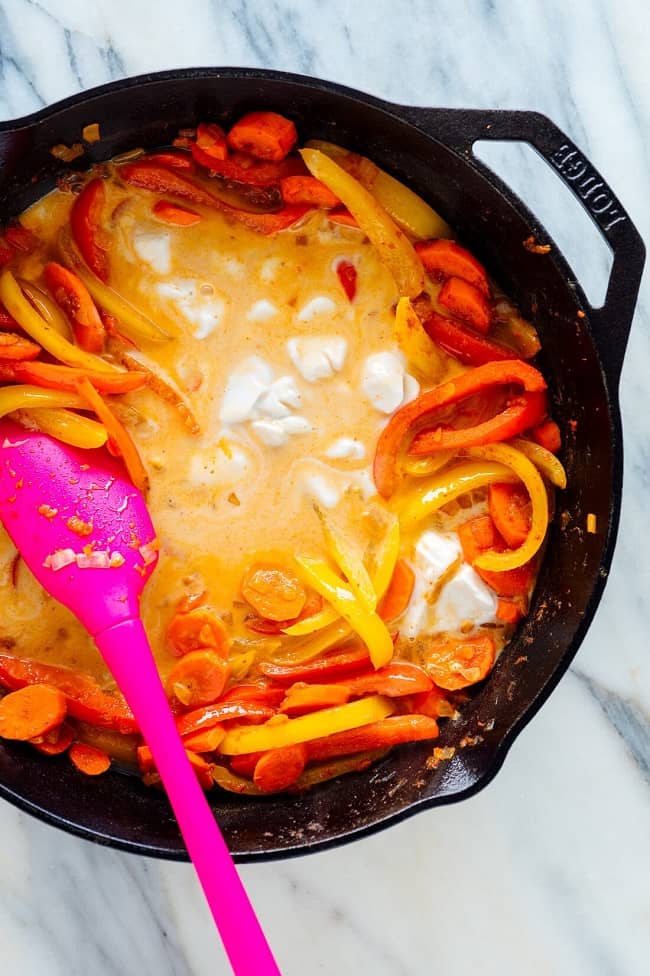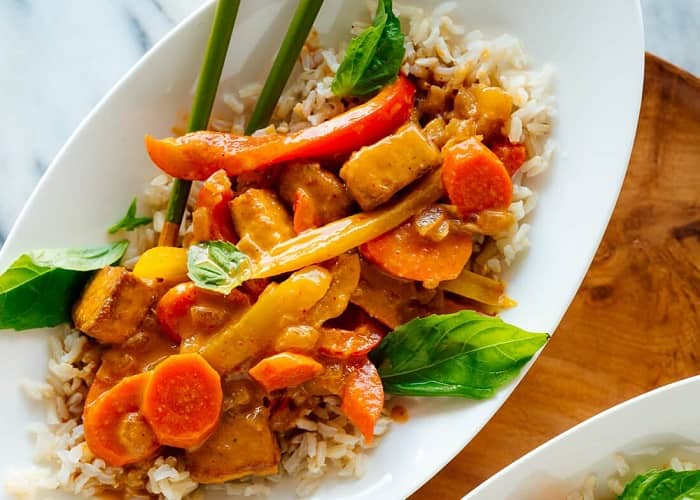- Food: Thai Panang Curry
- Writer: Nicolas Wilson
- Content-Type: Food Blog
Have you ever tried Panang curry? Thai Panang curry is thick and creamy, spicy but not overpowering, with hints of peanut and coconut.
My Panang curry contains a lot of bell peppers and carrots, as well as tofu for added protein. It’s a hearty midweek supper that’ll warm you up on a chilly day.
One of my favorite Thai curries, right up there with red and green curry, is Panang. You’ve been missing out if you haven’t tried it yet at your favorite Thai restaurant.
Notes about Panang Curry Paste
When it comes to Thai curries, the curry paste accounts for a large part of the overall flavor. To create Panang curry, you’ll need Panang curry paste.
What are the ingredients in Panang curry paste?

Dried chili peppers, galangal, ginger, lemongrass, kaffir lime zest, kaffir lime leaves, coriander root, coriander seeds, and cumin seeds are all common ingredients in Panang curry pastes.
If you have those items on hand, you could make your curry paste, but I’m guessing you don’t.
Special dietary requirements
If you’re a vegetarian (holler), vegan, or allergic to shellfish, look for a Panang curry paste that doesn’t include shrimp or fish sauce.
On Amazon, I discovered a couple of excellent vegan alternatives from A Taste of Thai and Maesri (those are affiliate links). If I had to choose one, I’d go with A Taste of Thai.
Where can I get it?
Panang curry paste is harder to come by than red or green Thai curry paste. You might be lucky and locate it in your grocery store’s international area, near the soy sauce. It’s more likely to be found in an Asian grocery store. You can also purchase it on the internet, as I did.
Notes about Panang Curry
I’ll be the first to admit that this isn’t a typical recipe. I altered the recipe to fit my vegetarian diet and attempted to include ingredients that are readily available in the United States. My dish differs from traditional curries in the following ways:
- I used vegan curry paste in this recipe (many contain shrimp).
- Kaffir lime leaves, which are usually cooked in coconut milk for added taste, were left out. They were nowhere to be found. Fortunately, this ingredient is included in the curry pastes I’ve advised.
- Instead of additional proteins, I used tofu (often shrimp or chicken).
- Instead of fish sauce, I used soy sauce. I used tamari, which is a gluten-free soy sauce made in Japan (most soy sauces are not). Simply put, I prefer the taste of tamari to that of soy sauce.
- Because I couldn’t find Thai basil, I topped the meal with normal basil. It was delicious that way, but if you can find Thai basil, it would be even better.
Before You Begin
I’d recommend cooking tofu beforehand if you want to serve it with your curry. Once the tofu is in the oven, you can begin making the curry. Here’s how to make it.
If you’d like to serve rice with your curry, I’ve included suggested quantities and instructions in the recipe below.
(I always cook with brown rice, but you may use any rice as long as you follow the package instructions.) The curry can be served with cooked noodles or on its own.
How to make Panang Curry?

Once you’ve chopped your vegetables, this curry recipe comes together quickly.
- To begin, sauté the onions, peppers, and carrots until soft, then add the garlic and curry paste and cook for a few minutes to bring out their flavors.
- Then stir in ordinary coconut milk (from a can) and a little water (to keep it from being too rich).
- You’ll add some last flavors at the end of cooking: peanut butter (which is common in Panang curries), tamari or soy sauce, and a little sugar and lime juice. The interaction of these components creates harmony and results in a tasty curry.
- To bring out the finest in the curry, I usually add a pinch of salt at the end. That concludes our discussion. If preferred, garnish with basil (Thai basil if available) and serve over rice or noodles.
recipe for Panang curry.
Thai Panang Curry
| 15-minute prep time
30 minutes to cook 45 minutes in total Serving: 4 servings |
This Thai Panang curry recipe is really simple to prepare at home and tastes even better than takeout! The tofu is optional in this recipe, which is packed with vegetables and a fresh taste. There are 4 servings in this recipe.
INGREDIENTS
- Optional: 1 batch of crispy baked tofu
- Optional: 1 ¼ cups brown jasmine rice or long-grain brown rice, rinsed
- 1 tablespoon coconut oil or olive oil
- 1 small white or yellow onion, chopped (about 1 cup)
- Pinch of salt, more to taste
- 1 red bell pepper, sliced into thin (¼” wide) strips
- 1 yellow, orange or green bell pepper, sliced into thin (¼” wide) strips
- 3 carrots, peeled and sliced on the diagonal into ¼” thick rounds (about 1 cup)
- 2 cloves garlic, pressed or minced
- 1 to 2 tablespoons Panang curry paste* (use 1 for mild or 2 for spicy)
- 1 can (14 ounces) of regular coconut milk
- ½ cup water
- 2 tablespoons peanut butter
- 1 tablespoon tamari or soy sauce**
- 1 ½ teaspoons coconut sugar or brown sugar
- 2 teaspoons fresh lime juice, to taste
- Optional garnishes: fresh Thai basil or regular basil, sriracha or chili garlic sauce for extra spice
INSTRUCTIONS
- If you want to serve rice with your curry (optional), prepare it as follows: A large pot of water should be brought to a boil. Continue to boil for 30 minutes after adding the rinsed rice, decreasing heat as needed to prevent overflow. Remove the rice from the heat, drain it, and return it to the pot. Cover the rice and set it aside for 10 minutes or more, until ready to serve. Season the rice with salt and fluff it with a fork just before serving.
- Warm a large skillet with deep sides over medium heat for the curry. Add the oil once it’s heated. Add the onion and a pinch of salt and simmer, stirring frequently, for about 5 minutes, or until the onion has softened and turned translucent.
- Add the carrots and bell peppers. Cook, stirring periodically until the bell peppers can easily be pierced with a fork, 3 to 5 minutes more. Cook, stirring constantly, for 1 minute after adding the garlic and curry paste.
- Stir in the coconut milk and water until everything is well combined. Over medium heat, bring the mixture to a simmer. Reduce heat to maintain a medium simmer and cook, stirring regularly, until the peppers and carrots have softened to your taste, about 5 to 10 minutes. Stir in the crispy tofu now if you’re using it.
- Turn off the heat in the pot. Combine the peanut butter, tamari, sugar, and lime juice in a mixing bowl. Season with salt to taste (I usually add a pinch or two). If the curry needs a bit more kick, add 1/2 teaspoon more tamari, or 1/2 teaspoon more lime juice for extra acidity.
- To serve, divide the rice and curry into bowls and top with fresh basil if desired. Serve with sriracha or chili garlic sauce on the side if you like your curries spicy.
Notes
- PANANG CURRY PASTE: Look for it in the Asian department of your supermarket. It’ll very certainly be found in Asian grocery stores, or you may order it online, as I did. A Taste of Thai and Maesri are two vegan/vegetarian brands that I enjoy. Not all brands are (fish sauce and/or shrimp paste may be present).
- MAKE IT GLUTEN-FREE: Instead of ordinary soy sauce, use gluten-free tamari. Check to see if your curry paste is gluten-free as well.
- MAKE IT VEGAN: Check to see whether your curry paste contains any shellfish or fish sauce. Please refer to the preceding suggestions.
- Remove the peanut butter and double-check that your curry paste is nut-free.
